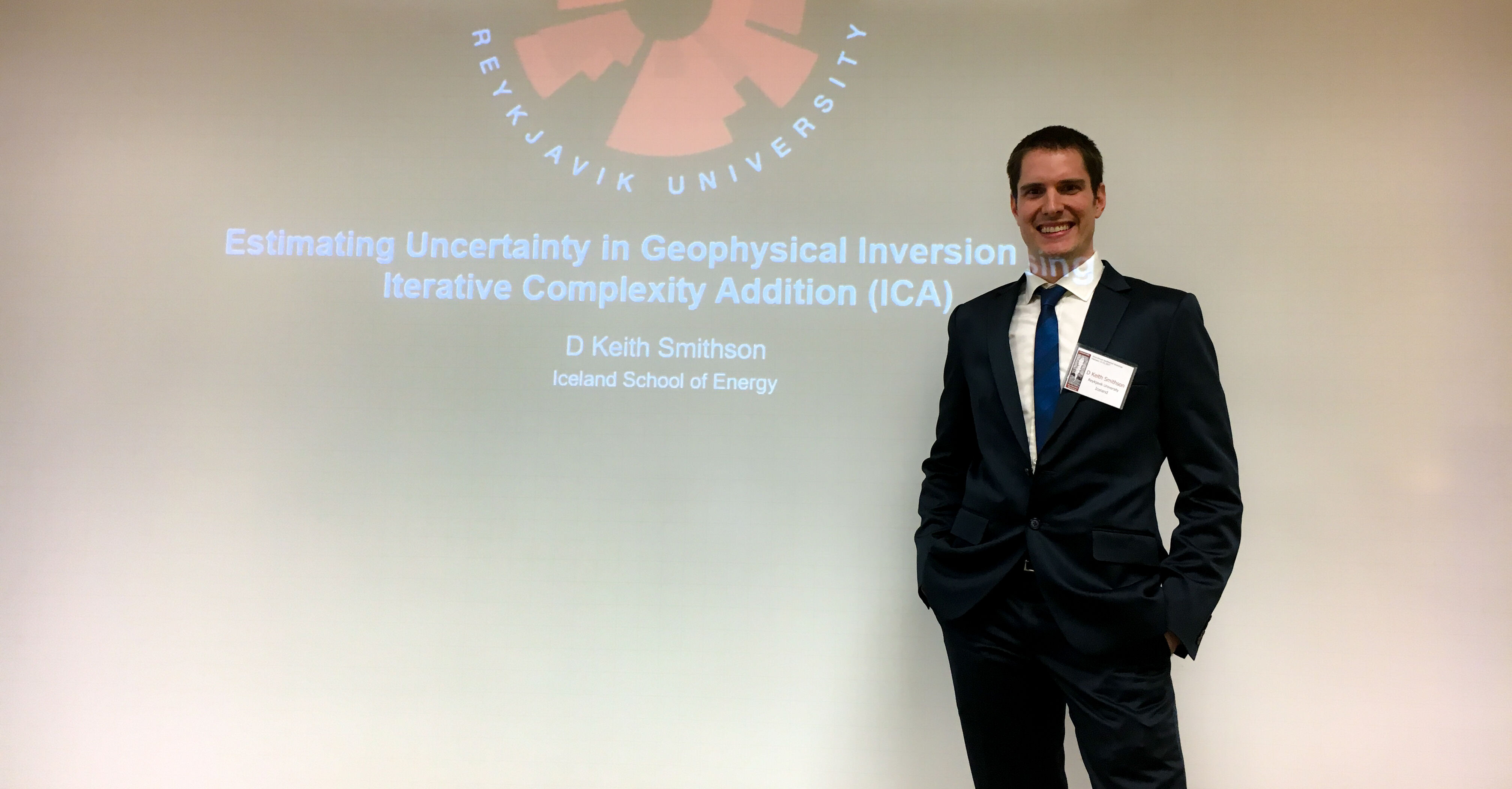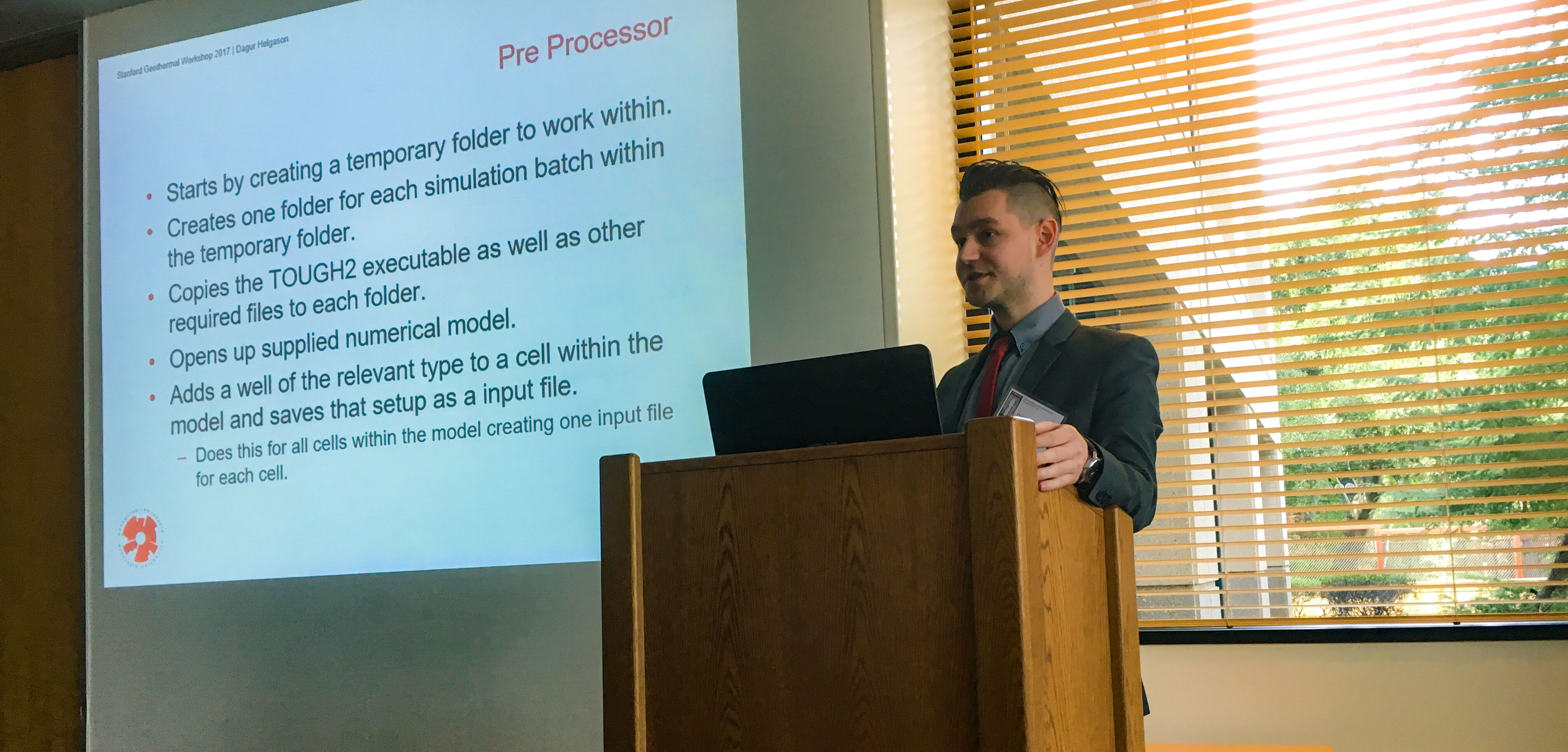42nd Annual Stanford Geothermal Workshop
ISE students speak on their research and network with academic & industry experts
STANFORD, February 13-15 - Flying in from Reykjavik, Iceland, ISE graduate students Dagur Helgason and Keith Smithson along with ISE PhD student Cari Covell and PhD & Assistant Professor María Sigríður Guðjónsdóttir attend the 42nd annual Stanford Geothermal Workshop. The workshop hosted around 300 academic experts and industry professionals who gave talks on the cutting edge of geothermal research and development. Most attendees presented projects they were working on including our three ISE students.
David Keith Smithson, second year ISE graduate student, saw the conference as a great opportunity to practice presenting the complex material from his soon-to-be-completed MSc thesis project to an academic audience. As expressed in the interview, he found the experience to be somewhat intimidating since there were few other masters students with participants mostly PhD students, postdocs and corporate professionals. Despite any intimidation, Keith found the feedback to be constructive and worthwhile for future development.
 As Keith presented at the conference, his thesis work centered on estimating the uncertainty in geophysical measurements. He explains, "the work seeks to quantify the value of these measurements by providing a process to measure the reliability of the data... by measuring the resistivity of the rock you are essentially measuring the conglomerate. The problem is that an infinite combination of possibilities can give the same resistivity curve - this is what we are dealing with." Keith expects to defend his thesis in May.
As Keith presented at the conference, his thesis work centered on estimating the uncertainty in geophysical measurements. He explains, "the work seeks to quantify the value of these measurements by providing a process to measure the reliability of the data... by measuring the resistivity of the rock you are essentially measuring the conglomerate. The problem is that an infinite combination of possibilities can give the same resistivity curve - this is what we are dealing with." Keith expects to defend his thesis in May.
At the workshop Dagur Helgason also presented his defended MSc thesis work, which focused on an algorithm for optimal well placement in geothermal systems based on TOUGH2 models. Like Keith, he found the feedback on his work to be useful, especially with regards to the assumptions made in his algorithm.

Having defended his thesis in January however, Dagur came to the workshop seeking more than feedback on his thesis. With hopes of making new industry connections, Dagur found that there was too much of a focus on academic and theoretical projects and not enough work applicable in industry. Dagur adds, "while there were a lot of interesting presentations and topics, the workshop seemed more like an update-on-current-work than a workshop. There were fewer new projects grounded in industry than I expected."
Nevertheless, Dagur found the event to be worthwhile. Of the presentations he attended he found particular interest in Radial Jet Drilling and Thermal Spallation Drilling. In addition to presenting his work and listening to talks, Dagur had a chance to speak with industry members and successfully made new connections as intended.
For both Dagur and Keith, this was their first time at the Stanford Geothermal Workshop but for Cari Covell, the workshop was quite familiar. Like Dagur and Keith, Cari presented an update on her PhD thesis work and gained valuable information on how to proceed. What's more, having attended the workshop in the year prior, she found interesting differences and similarities between her two consecutive visits. Last year, Cari found the workshop to be more populated by students while this year there were more industry professionals and academics, echoing Keith's observations above.
Cari further notes that while the style of the workshop was similar to her previous visit, the political situation in the United States created a different air about the event. She passionately gave insights about this in her interview and discussing the effects on government jobs, which is a future career goal for Cari.
"There were no real discussions about future projects. The industry seemed mainly focused on adapting to the new Trump Administration, as the workshop was opened by the Geothermal Technologies Office (GTO) of the Department of Energy (DOE) to directly address concerns. The GTO stated that the Administration is interested in creating jobs and making money, leaving an opportunistic impression, but only focusing on this year's projects and corresponding budgets... Any time you go to a workshop, there's a lot of enthusiasm and this year there was less so due to the uncertainty in what's to come."
Despite the perceived uncertainty of the workshop and different levels of feedback from the students, the 42nd Annual Stanford Geothermal Workshop undoubtedly created a platform for old and new colleagues in the energy sector to both connect, and reconnect. This certainly rang true for Cari, who enthusiastically mentions that it was great to reunite with her old peers from Cornell University. Cornell and the Iceland School of Energy have been in strong cooperation for several years, often exchanging students for semester periods to give them the opportunity to experience a different learning environment and provide a new avenue to network.
Overall, all three students found the event to be exciting, useful and informative. The trio are now back in Iceland, finishing their respective degrees and continuing their involvement in industry.
Authors of the presentation on Radial Jet Drilling are Rohith Nair, Elisabeth Peters , Saulius Šliaupa , Robertas Valickas and Sigitas Petrauskas.Authors of the presentation on Thermal Spallation Drilling are Michael A. Kant, Edoardo Rossi, Dragana Höser and Philipp Rudolf von Rohr.
